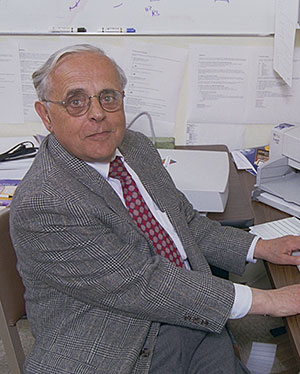Juerg Xaver Saladin
DOI: 10.1063/PT.3.2826
Juerg Xaver Saladin, a pioneer in nuclear structure studies and a professor emeritus at the University of Pittsburgh, passed away on 29 May 2014 in Pittsburgh, Pennsylvania.

Juerg Xaver Saladin
UNIVERSITY OF PITTSBURGH CIDDE

Born on 25 July 1929 in Solothurn, Switzerland, Juerg pursued his undergraduate and doctoral studies at ETH Zürich, from which he received BS and PhD degrees in nuclear physics in 1954 and 1959, respectively. His doctoral thesis on nuclear scattering and polarization was completed under the direction of Pierre Marmier. As a postdoctoral researcher at the University of Wisconsin–Madison, Juerg continued to pursue his interest in polarization measurements in transfer reactions.
Juerg joined the faculty of the department of physics and astronomy at the University of Pittsburgh in 1961. Shortly afterward, he began his research studies using the newly installed, and the world’s first, three-stage Van de Graaff accelerator. He was among the first to use the reorientation effect in Coulomb excitation to carry out precise measurements of the quadrupole moments of nuclear excited states and infer nuclear shapes. Particularly noteworthy were his group’s comprehensive studies of the transition of nuclear deformation from a prolate shape to an oblate shape.
In the early 1970s, Juerg developed a quantum mechanical formulation of the Coulomb excitation process, which allowed a more accurate computation of cross sections compared with the earlier semiclassical calculations. That code was used for an extensive study of hexadecapole deformation in rare-earth nuclei. His results showed a beautiful evolution from positive deformation values (“barrel” nuclei) at the beginning of the nuclear shell to negative values (“clover-leafed” nuclei) in the second half of the shell.
In the 1980s Juerg used gamma-ray spectroscopy to study nuclear structure at high spins. He conceived and constructed the Pittsburgh array of Compton-suppressed germanium detectors—a first for a university group. He and his collaborators used the array at several laboratories to explore the structure and shapes of nuclei, how different shapes might coexist and mix, and how nuclear shapes could evolve with increasing angular momentum. That work, with collaborators who were, in many cases, his former students, culminated in studies of highly elongated “super-deformed” medium-mass nuclei.
Juerg was the director of Pitt’s Nuclear Physics Laboratory from 1980 until 1997. Although he retired from the university in 1998, he maintained his passion for nuclear physics and continued his research for many years as a professor emeritus.
During an academic career spanning nearly 40 years, Juerg mentored more than 30 graduate students and postdoctoral fellows. Not only did he provide his students with a superb, broad, and balanced training experience, he also invariably acted as their greatest advocate as they launched their careers. Remarkably, Juerg continued his personal and professional association with his former students long after they had graduated, and he followed their careers with great interest. Many of his former students considered him a dear friend and a father figure to whom they turned regularly for support, wise counsel, and sound advice. Their appreciation was in evidence when 17 of his former students, including several from overseas, attended the symposium held in honor of his retirement.
A lover of classical music, Juerg had a great sense of humor and was full of interesting life stories, which he loved to relay. A particularly memorable event occurred when he was a young captain in the Swiss Army and was leading an armored column on practice maneuvers during a storm. They got lost and arrived at a nondescript barbed-wire fence. Undeterred, Juerg ordered the wires to be cut and the column to keep moving. Sometime later, the column reached a border crossing that was manned by French border guards—on the wrong side! Only then did he realize that they had been conducting their military exercise in the wrong country, making him the most recent commander to invade France.
Juerg had boundless energy and a contagious enthusiasm for science, which he conveyed to the next generation. He will be remembered for his warm, vibrant personality and for the profound and lasting effect he has had on his friends, students, and colleagues.
More about the Authors
Cyrus Baktash. US Department of Energy, Germantown, Maryland.
I-Yang Lee. Lawrence Berkeley National Laboratory, Berkeley, California.
